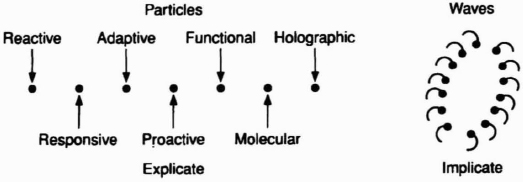The Principle of Complementarity
The quantum physicists, as distinguished from the Newtonian classicists, have demonstrated that at the atomic level matter has a dual aspect; it appears as particles and as waves. Light, for example, is emitted and absorbed in the form of “quanta” or photons, but when these particles of light travel through space they appear as vibrating electromagnetic fields which show all the characteristic behavior of waves (see figure 14.1). Similarly, in this chapter, we have alternated between “particle” and “wave” orientations, both of which are required for total learning and for quality management.
Particles of learning and of innovation, of development and of transformation, are the seven discrete “horizontal” elements, or states, of the spectrum. Waves of learning and innovation, of development and of transformation, are represented by the “vertical” and essentially interconnected flows. These involve both the inner journey, between physical reality and creative imagination, as well as the outer journey, between vision and action.
Alternatively, these complementary forces – “classical” particles and “romantic” waves – also make up the two sides of quality. Moreover, in David Bohm's terms, they represent the respectively explicate and implicate orders (see figure 14.2).

Figure 14.2 The explicate and implicate orders
Get Beyond Leadership: Balancing Economics, Ethics and Ecology, Revised Edition now with the O’Reilly learning platform.
O’Reilly members experience books, live events, courses curated by job role, and more from O’Reilly and nearly 200 top publishers.

